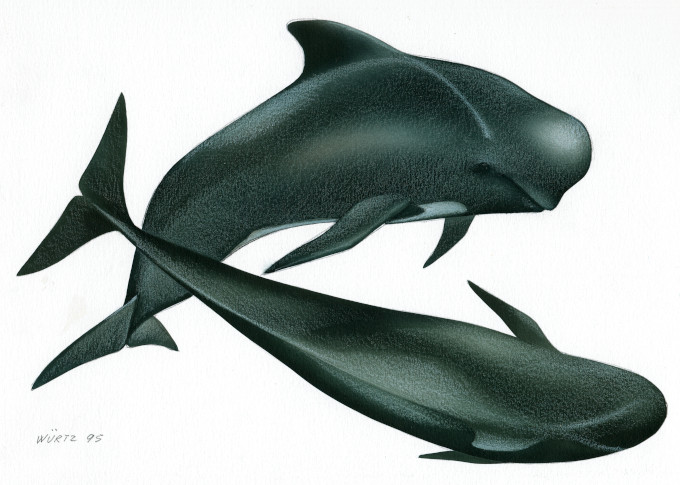Pilot whale
Kingdom: Animalia
Phylum: Chordata
Class: Mammalia
Order: Cetartiodactyla
Infraorder: Cetacea
Parvorder: Odontoceti
Family: Delphinidae
Genus: Globicephala
Species: Globicephala melas (Trail 1809)

Description
The pilot whale exhibits sexual dimorphism, with the male reaching almost 7 meters in length and weighing 2.3 tons and the female slightly smaller (about 5.5 meters).
The body is massive, and the rostrum is barely noticeable due to the globe shape of the head. The coloration is ebony black or dark brown in adults, while in juveniles light hazel. A white spot on the chest and belly in the shape of an inverted anchor is always present in the adult.

The species is distributed in temperate and subpolar waters and is found in pelagic and coastal areas of the North Atlantic and North Sea.
In the Mediterranean, pilot whales are present in the Strait of Gibraltar, Alboran Sea, and the Corsican-Ligurian Provençal Basin. In Italy, sightings are concentrated in the Ligurian Sea and Sardinia. The only known nucleus in our study area has disappeared through the years.
The pilot whale is a gregarious species par excellence, forming groups of a few dozen to hundreds of specimens.
The species feeds at depth and especially on cephalopods.
Mediterranean Conservation Status
In 2021, the Mediterranean subpopulation of pilot whales moved from the category of Data Deficient to Endangered.

Mediterranean pilot whales are genetically isolated from the North Atlantic population, and estimates count less than ~2,500 mature individuals. Over the past 10 years, they have suffered a steady decline due to several factors: a morbillivirus outbreak in 2006, high levels of contaminants, disturbance by shipping and whale-watching, and interactions with fisheries. A population decline of 35 percent over three generations has been predicted.
Listed in
CMS App. II (only North and Baltic Seas populations)
CITES App. II
Bern Convention App. II
Barcelona Convention SPA/BD Protocol, Annex II
Global status
Least Concern
The local nucleus
Beginning in 1995, a stable group of pilot whales has been documented as semi-stationary off Ventotene Island.
In 1995, the pod consisted of 6 photo-identified individuals: three adult males (Cagliostro, Santiago, and Enea), one adult female (Señora), one juvenile female (Emma), and one immature male (Pan). The pod was led by the largest male, the "pilot" Cagliostro, as observed in other social groups of this species.

In 1996, one of the adult males (Enea) disappeared; later, in 1999, a newborn was recorded in the pod. Our observations documented that Cagliostro, the "pilot," was constantly taking care of the juvenile Pan (about 5-6 years old), remaining isolated from the rest of the pack. On the other hand, the two females and the second male in the group were clustering with the newborn, perhaps in defense.
From 2000 to 2004, we regularly spotted only Cagliostro and Pan; the other members of the group were never encountered again. In 2006 Cagliostro and Pan were last sighted; the animals were together with a female and a newborn.

Sightings have almost always occurred southwest of Ventotene in a narrow stretch of sea (3 km2) corresponding to an undersea crater not described in the literature, which we nicknamed "Globibar." However, the last sightings in 2006 occurred southwest of Ischia, in the canyon of Punta Imperatore.
Acoustics
The pilot whale has a varied acoustic repertoire; several associations between sounds and behavior have been documented; however, there is no information on the degree to which whistles are stereotyped and have a "signature" function.

Thanks to the temporal continuity of our observations, it was possible to record and catalog the sounds emitted by the pilot whales of Ventotene.
All whistles (No. 899) were cataloged according to their shape and assigned to individuals by observing the air bubbles emitted during the production of whistles while bow riding. The results of the analysis showed that the pilot whales predominantly (80%) produced their signature whistle. The calls of males were predominant (80%). All whistles have an introductory structure. The juvenile male, Pan, developed this introduction only in 1996, and in the same year, he introduced an additional final vocalization to his call.

